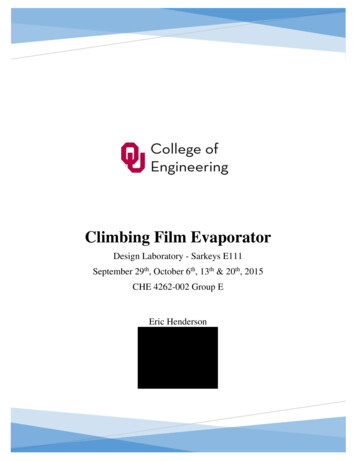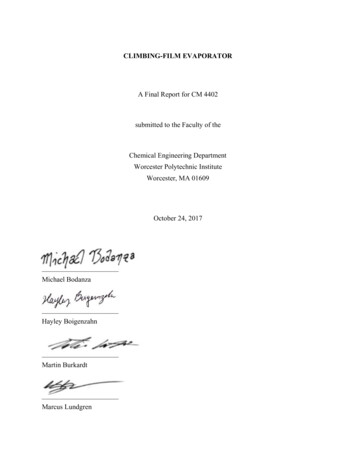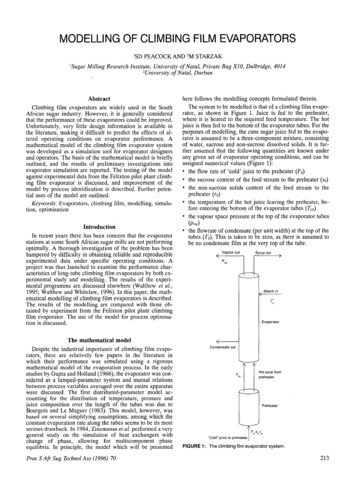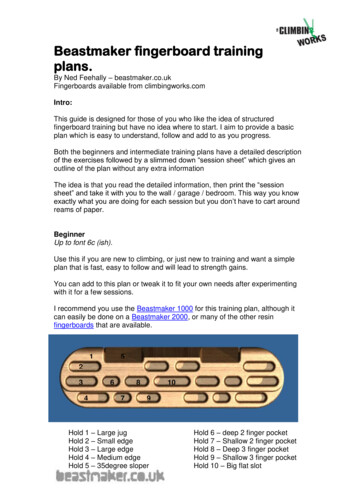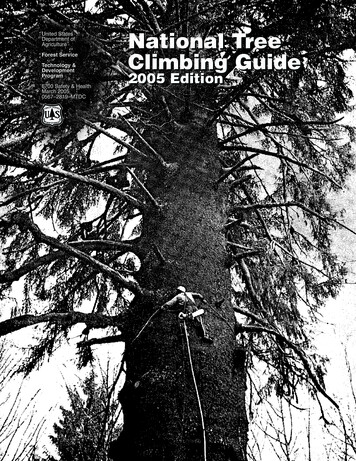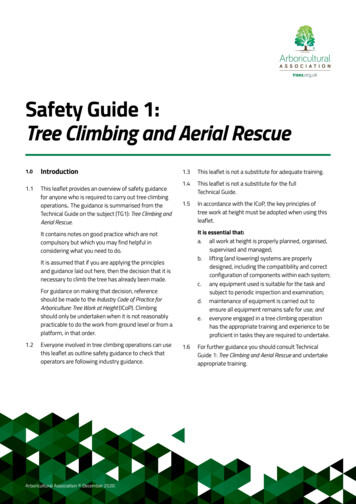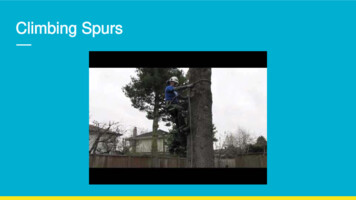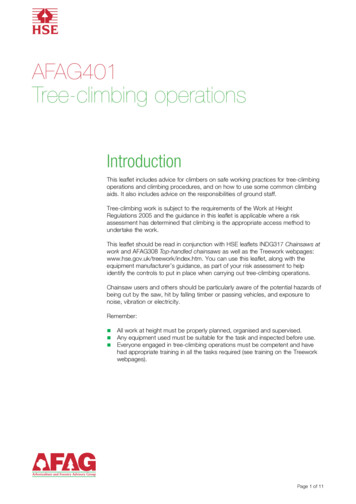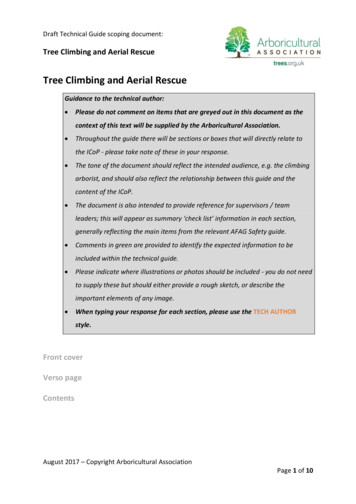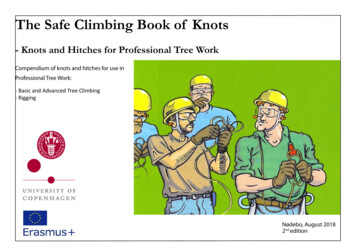
Transcription
The Safe Climbing Book of Knots- Knots and Hitches for Professional Tree WorkCompendium of knots and hitches for use inProfessional Tree Work:- Basic and Advanced Tree Climbing- RiggingNødebo, August 20182nd edition
A brief introduction to ropes, knots and hitches.Although mechanical friction devices are used more and more both on climbing ropes and in rigging, knots and hitches are still anall-important part of the Arborist’s skills. A great deal of your system will often be tied together with knots of various types. There isa lot of useful knots for use in Professional Tree Climbing and each week, new ones are appearing. You must be able to tie the mostimportant ones: The same way a carpenter must be able to use a hammer when the nail-gun fails, the Arborist must master knots as apart of her or his daily routine. When stress and tiredness set in, your life may depend on your ability to tie your knots correctly.The knots and hitches in this book are chosen due to their effectiveness, they are easy to tie and easy to undo. Common to all ofthem are that they must be mastered and used – OFTEN. Otherwise they will be forgotten, and you will be tempted to tie nondescript knots that either undo themselves or are impossible to loosen.DefinitionsA knot is used to join two ropes together or a rope to itself. If done correctly a knot will hold shape regardless of it being fixed to something else.A hitch is used to fix a rope or a line to another object, such as a carabiner or pole, and relies on that object to hold. (By the way: Arope is an un-occupied line. As soon a rope has a purpose, it become a line). You can see this easily by tying a figure-of-eight follow-thru onto a carabiner. Do the same with a clove hitch. Now take the carabiner away and see what happens – one of them will fallapart. Some sources classify a hitch as a class of knot but the general distinction remains the same.No knot is “Nearly correct”. Tying a knot or a hitch, the result is either correct or hopelessly wrong. A knot or a hitch works throughits inner friction (Not to be mistaken with the friction in Friction Knots). This inner friction is a friend and an enemy. The better thefriction the better the knot will hold, but the same friction can also make the knot near to impossible to loosen. On some types ofrope, certain knots can weld itself together.It can also be of great importance if a knot is tensioned or not all the time. Some knots will become undone under cyclic tension.2
When tying a knot, remember “Tie, Dress and Set”:1.2.3.Tie the knot.Dress the knot so it looks right and lies neat.Set (tighten) the knot.When a knot or a hitch is finished, someline will be left. This part is called thetail end or the working end. This is theknot’s safety margin. No matter howhard you set the knot, it will yield or rollunder tension. To prevent the knot frombecoming undone, the rope manufacturer states a minimum length of the tailend, as a rule 5 times the diameter of therope. In this compendium, we use thislength as a standard. Where the lengthof the tail end is of certain importance,you will see this little drawing beside theknot:You will meet the concept “Eye-to-Eye” or “E-2-E”. This is a rope, i.e. a friction line,termiated with a sewn or spliced eye from the manufacturer.3
The manufacture and construction of the rope is of great importance of how a certain knot hold. On very smooth ropes (I.e.fishing line and HPME/Dyneema), you will have to use particular knots to assure durability. On other types of rope evensimple knots will lock or jam beyond loosening.In general, a rope is weakened when you tie a knot on it. The reason is that the fibres in the bights and turns you use to formthe knot tightens on the outer side and are loose on the inner side. Because of this the outer side carries all the tension, the inner side is slack and carries no weight.How much the knot weakens the rope depends on the diameter of the rope and which type of knot. Several researches havebeen made on the subject, and the conclusions differs slightly, but there are some common points:A knot reduces the strength of a rope. Some knots reduce the strength of a given rope more than other.Some type of ropes is weakened more with a given knot than other.The thinner the rope, the more it will be weakened by a given knotThere is no big difference in the strength of the knot whether the rope is wet or not.As a general rule, the weakening on a rope from a tied knot is set to 50%.When testing a new type of knot, remember: Low and slow, till you know how the knot is tied and how it performs.In this book, we will go through the most common Arborist knots and hitches approximately in the order theyappear during your training, starting with the overhand knot, ending with the more tricky “French Prusiks”.When accessing the pages with the various knots, you will see a QR-code: You can either click the QR-codewith your mouse, to get to a site where you can see the knot tied, or you can “shoot” the QR-code with a readeron your smartphone or I-phone.Many knots will have more than one name. These names are often related to trade or country. We have tried to place the mostused name first, with the other names in brackets.4
Knot Terminology:Bend:Joins two ropes or lines.Bight:Made by folding a piece of rope so that the two parts lie alongside each other. When tied nearthe rope's end, the parts will be the Tail lying beside the Standing End. A bight can be used tofinish many knots - making them easy to untie by just pulling the tail. The term "Bight" does notimply a "Loop" and does not mean the same.Dressing a Knot:Arranging the components of the knot to optimize security and/or strength.Hitch:Attaches a rope to something, e.g., a karabiner, branch, tool or equipment.Knot:Joins two ropes together or a rope to itself.Loop:Made when a rope forms a partial circle with the ends crossing each other.Round Turn:Two passes of a rope round an object – to completely encircle it.Slipped:A knot is Slipped when it is completed using a loop or loops. The best known example is theSlip Knot or the Slipped Double Overhand. Many of the knots described can be slipped. Using aloop makes them less secure - think of shoelaces - but they are released more easily.Splice:A knot made using the strands of a rope rather than the whole rope – stronger than ordinaryknots and intended to be permanent.Standing End:The long end - the part not knotted. The standing part lies between the standing end and theknot.Stopper Knot:A knot in the end of a rope – used to prevent fraying or to prevent the end passing through ahole.Strands:The major components of a rope – three in a three-strand rope. Each "Strand" is made up ofmany separate fibers.Tail:The short end – the part getting knotted.Turn:One pass of the rope round or through an object.5
Stopper KnotsOverhand Knot:”Mother of all knots”. The Overhand Knot is the simplest of the Single-Strand Stopper Knots. It can also be used to preventthe end of a piece of rope unraveling. Not much used in practical Arboriculture.Tying:Form a loop and pass the end through it. Tighten it to form the Overhand Knot. When pulled tight it can function as a simplestopper knot.6
Slip Knot:Running Knot and Slip Knot are terms used for a broad array of knots that indicate it can easily be spilled by pulling onthe working end of the rope. The Slipped Overhand is the simplest of such knots and is often referred to as a Slip Knot orRunning Knot even though those are broad terms. Historically this simple knot has been used to snare birds and other smallanimals. It can also be used as a stopper knot that can be quickly released.7
Figure-of-eightThe Figure Eight is a general-purpose stopper knot that replaces the common Overhand Knot in many uses. It provides a quickand convenient stopper knot, it doesn’t bind and it can be undone easily. The Figure-of 8 is also important to climbers becauseit is the basic for the Double Figure-8 Loop.Tying:Pass the tail over itself to form a loop. Continue under and around the standing end. Complete the knot by passing the taildown through the loop.8
Double Overhand Knot:The Double Overhand Knot is primarily used as a stopper knot, but is also basis for Double Fisherman’s Knot andDouble Overhand Loop.Tying:As with the Overhand Knot, but with one additional turn.9
Termination Knots:Figure-8 LoopThe Figure Eight Loop is used to put a fixed loop in the end of a rope, or around an object. It is relatively easy to tie and issecure, but can become difficult to untie after heavy loading, and can jam badly in any rope type. The Figure-8 Loop is easy toteach to beginners and quickly verify that it has been tied. It can be secures with a Double Overhand Knot.Tying:One can easily make a loop by doubling the rope, then tying the standard Figure Eight Knot. The knot can be secured with aDouble Overhand Loop10
Double Overhand Loop:Double Overhand Loop is a very secure hitch knot. It is used to bind a line to a carabiner.Tying:The technique is to create a Double Overhand Knot around the standing end. A common mistake when learning is failing tocomplete the second turn, making only a single Overhand knot which is not secure.11
Joining Knots:Double Fisherman’s Knot:The Double Fisherman’s Knot or Grapevine Knot is a bend used to join two lengths of rope. This knot and the triple fisherman’s knot are the variations used most often in climbing, arboriculture, and search and rescue. A primary use of this knot isto form high strength loops of cord, called a Prusik Loop, for connecting pieces of a climber’s protection system. The knot canlock up so tightly that is is effectively welded together.Tying:The Double Fisherman’s Knot consists of two double overhand knots each tied round the other standing end. However, because it is created around another line, this structure may not be obvious.The Double Fisherman’s (Grapevine Bend) is not complicated. Nevertheless, it can be tied wrongly and then fail. If you tie itand your life depends on it, inspect it carefully. If someone else ties it, inspect it extremely carefully.Cont. on next page12
13
Friction Knots:Prusik:A Prusik is a friction hitch or knot used to put a loop of cord around a rope, applied in climbing, canyoneering, mountaineering, caving, rope rescue, and by arborists. The term Prusik is a name for both the loops of cord and the hitch, and the verb is”to prusik”.The Prusik hitch is named for its alleged inventor, Austrian mountaineer Dr. Karl Prusik. It was shown in a 1931 Austrianmountaineering manual for rope ascending.One component of the Prusik Knot is the Prusik Loop. This loop can be made using a short section of rope joined by a DoubleFisherman’s Knot. Alternatively, the loop may be purchased, already formed, from climbing shops. Due to its symmetric nature, Prusik hitches have the advantage of working in both directions. Most mechanical rope-grabs work like a ratchet, movingfreely up the rope, but grabbing when a load is placed down on them. Traditional Prusiks will grab when pulled by the tail,either up or down, and will slide either way when pushed by the barrel.The function of the knot depends on number of turns,size of climbing line, weight of the climber and if the weather is wet or dry. It’s important that you find your own combination.14
DistelThe Distel Hitch is a directional friction hitch that is often employed by arborists. It is used to attach a carabiner to a rope,allowing a climber to ascend or descend.The Distel Hitch is credited to a German climber named Uli Distel who, it has been said, attempted to tie the Schwabisch butneglected to change the direction of the split-tail when he made the turns above the bridge. As it turned out, this arrangement worked well for climbing!15
Blake HitchThe Blake’s Hitch is a friction hitch commonly used by arborists and tree climbers as an ascending knot. Unlike other commonclimbing hitches, which often use a loop of cord, the Blake’s hitch is formed using the end of a rope. Although it is a stableknot, it should be backed up with a stopper knot, such as a Figure Eight Knot, for safety. It is used for both ascending and descending, and is preferred by many arborists over other hitches, as it is less prone to binding.The Blake’s Hitch should always employ a stopper knot (not shown in the animation) to prevent the free end from working itsway back through the hitch. If the hitch does not hold securely due to slickness of the standing line, an extra turn should bemade around the line, with the end still tucked only under two. Additionally, the strain should only be applied from ”below”the hitch.16
KnutThe knot was introduced by climbing instructor Knut Foppe around the millenium and is therefore one of the ”new” frictionknots.The Knut is a good alternative to the Distel, it has a good grip, is easy to move and binds effectively when you let go ofit. The knot can be adjusted by increasing or reduce the number of turns. Ususally, a wheel is added behind the knot tomake length reduction easier, but the knot can be moved forward quite easily without the wheel. The Knut is slightly morecomplicated to tie than the Distel.When using a wheel on a steel core lanyard, the wheel must be connected with a cut-able link.17
KlemheistThe Klemheist Knot (klem is the Dutch word for ”clamp”) is a type of friction hitch that grips a rope whenweight is applied, and is free to move when the weight is released. It is used similarly to a Prusik knot to ascendor descend a climbing rope. One advantage is that webbing can be used as an alternative to cord. The Klemheistis easier to slide up than a Prusik.18
SchwabischThe Schwabisch is a directional friction hitch that is popular with arborists. It is used to attach a carabiner to a rope,allowing a climber to ascend or descend. Can be confused with the Distel. The Schwabisch moves easier than t
Professional Tree Work: - Basic and Advanced Tree Climbing - Rigging 2nd edition Nødebo, August 2018 . 2 A brief introduction to ropes, knots and hitches. Although mechanical friction devices are used more and more both on climbing ropes and in rigging, knots and hitches are still an all-important part of the Arborist’s skills. A great deal of your system will often be tied together with .

